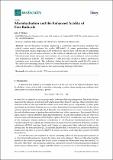Files in this item
Microhydration and the enhanced acidity of free radicals
Item metadata
| dc.contributor.author | Walton, John Christopher | |
| dc.date.accessioned | 2018-02-26T15:30:08Z | |
| dc.date.available | 2018-02-26T15:30:08Z | |
| dc.date.issued | 2018-02-14 | |
| dc.identifier | 252297126 | |
| dc.identifier | bf36221d-9c69-4668-be6f-4b8f439a161a | |
| dc.identifier | 85042208473 | |
| dc.identifier | 000426436300203 | |
| dc.identifier.citation | Walton , J C 2018 , ' Microhydration and the enhanced acidity of free radicals ' , Molecules , vol. 23 , no. 2 , 423 . https://doi.org/10.3390/molecules23020423 | en |
| dc.identifier.issn | 1420-3049 | |
| dc.identifier.other | ORCID: /0000-0003-2746-6276/work/56638779 | |
| dc.identifier.uri | https://hdl.handle.net/10023/12786 | |
| dc.description | The author thanks EaStCHEM for financial support. | en |
| dc.description.abstract | Recent theoretical research employing a continuum solvent model predicted that radical centers would enhance the acidity (RED-shift) of certain proton-donor molecules. Microhydration studies employing a DFT method are reported here with the aim of establishing the effect of the solvent micro-structure on the acidity of radicals with and without RED-shifts. Microhydration cluster structures were obtained for carboxyl, carboxy-ethynyl, carboxy-methyl, and hydroperoxyl radicals. The numbers of water molecules needed to induce spontaneous ionization were determined. The hydration clusters formed primarily round the CO2 units of the carboxylate-containing radicals. Only 4 or 5 water molecules were needed to induce ionization of carboxyl and carboxy-ethynyl radicals, thus corroborating their large RED-shifts. | |
| dc.format.extent | 1271388 | |
| dc.language.iso | eng | |
| dc.relation.ispartof | Molecules | en |
| dc.subject | Free radicals | en |
| dc.subject | Acidity | en |
| dc.subject | DFT computations | en |
| dc.subject | Hydration | en |
| dc.subject | QD Chemistry | en |
| dc.subject | NDAS | en |
| dc.subject.lcc | QD | en |
| dc.title | Microhydration and the enhanced acidity of free radicals | en |
| dc.type | Journal article | en |
| dc.contributor.institution | University of St Andrews. School of Chemistry | en |
| dc.contributor.institution | University of St Andrews. EaSTCHEM | en |
| dc.identifier.doi | 10.3390/molecules23020423 | |
| dc.description.status | Peer reviewed | en |
This item appears in the following Collection(s)
Items in the St Andrews Research Repository are protected by copyright, with all rights reserved, unless otherwise indicated.

